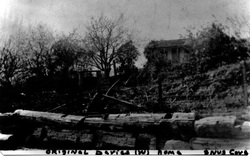Early Days: 1874-1910

William Davies' original homestead in Snug Cove
The first settler to pre-empt land on Bowen did so in 1874. William Eaton claimed 160 acres south of Killarney Lake but subsequently squatted at Deep Bay, where he established a house, orchard and barn.
From that time until the turn of the century, Bowen was a hive of industrial activity. Early settlers planted extensive farms and orchards, the Island was selectively logged between 1896 and 1899, and a brickworks was established on a rare blue clay deposit found in Deep (Mannion) Bay. On logged-out lands in Tunstall Bay, the Western Explosives Company set up a dynamite plant.
The Island's population was extremely diverse in the early days. Several of the settlers married Indian women. Industrial activity attracted workers, investors and settlers from Japan, China, Sweden, Philippines, Spain, the US, the UK and of course, across Canada. The first homes were rustic cabins of log or pole construction and the only roads were those built to skid logs to Snug Cove. It was 1893 before the one-room schoolhouse was built. While the Island and surrounding waters provided bountiful fresh food, most staples still came from the mainland. William Davies' general store in Snug Cove stocked some provisions but for the most part, settlers depended on Terminal Steamship Lines for supplies.
From that time until the turn of the century, Bowen was a hive of industrial activity. Early settlers planted extensive farms and orchards, the Island was selectively logged between 1896 and 1899, and a brickworks was established on a rare blue clay deposit found in Deep (Mannion) Bay. On logged-out lands in Tunstall Bay, the Western Explosives Company set up a dynamite plant.
The Island's population was extremely diverse in the early days. Several of the settlers married Indian women. Industrial activity attracted workers, investors and settlers from Japan, China, Sweden, Philippines, Spain, the US, the UK and of course, across Canada. The first homes were rustic cabins of log or pole construction and the only roads were those built to skid logs to Snug Cove. It was 1893 before the one-room schoolhouse was built. While the Island and surrounding waters provided bountiful fresh food, most staples still came from the mainland. William Davies' general store in Snug Cove stocked some provisions but for the most part, settlers depended on Terminal Steamship Lines for supplies.



